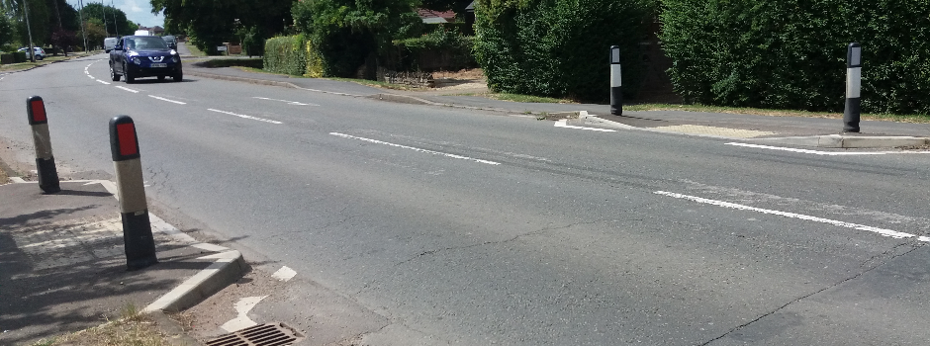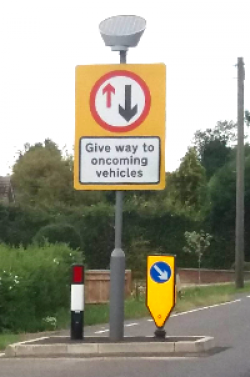Local Highway Improvements (LHI)’s are delivered by the County Council on a joint funded basis and applicants can apply for funding of up to either £25,000 for complex projects or £10,000 for non-complex projects, as a contribution to their scheme. The applicant is expected to provide a minimum contribution of 10% towards the total scheme cost.
Road narrowing (Complex)

Road narrowing simply reduces the width of the road. This can be achieved through physical measures such as kerb build outs or central islands, or the use of coloured surfacing or road markings (sometimes called psychological traffic calming). The treatment most commonly used in Cambridgeshire is the construction a build out at each side of the road. This can be combined with a pedestrian crossing point as it helps pedestrians cross the road more easily. In this case, the kerb is dropped with tactile paving where the pavement slopes towards the road.
Drivers will need to drive more carefully in a narrowed section of road to keep their vehicle in the correct road position, which may result in slower vehicle speeds.
Effectiveness
Narrowings are a horizontal treatment that can reduce vehicle speeds. Reducing vehicle speeds increases safety because:
- The vehicle has travelled a shorter distance by the time a driver can react to a hazard
- Braking distance is reduced, so the vehicle can stop more quickly before a hazard
- Higher speed crashes tend to result in higher severity injuries
Advantages of road narrowing
- Targets a specific part of the road
- Can prevent vehicle parking
- Make it easier for pedestrians to cross
- Emergency vehicles should be able to pass without slowing down
Disadvantages of road narrowing
- Not as effective as vertical treatments
- Managing water drainage could be complex and costly
- Cyclists may feel intimidated by some vehicle drivers' behaviour at road narrowing
- Can resemble a sheltered parking bay and encourage parking each side which can mask pedestrians.
Restrictions
- Road narrowing should not be used on junctions with any heavy goods vehicle traffic.
-
This scheme requires a Traffic Regulation Order and a Road Safety Audit.
Cost of installation
- £14,000
The road narrowing cost is based on one pair of narrowing’s, installed under two-way lights. There is no provision for drainage.
Priority narrowing (Complex)

Priority narrowings require one direction of traffic to give way to oncoming vehicles. The narrowing consists of a build out and bollard in one half of the road or built out slightly from both sides, with a sign to show who has priority. For the lane without priority, there are Give Way markings on the approach.
Groups of narrowings can be placed with alternating priority down a road, so that each direction of vehicle traffic may have to stop and give priority in equal measures.
Effectiveness
Priority narrowings are a horizontal treatment which can reduce vehicle speeds. Vertical treatments - such as speed cushions or speed tables - are more effective at consistently keeping speeds lower over a longer length.
Reducing vehicle speeds increases safety because:
- The vehicle has travelled a shorter distance by the time a driver can react to a hazard
- Braking distance is reduced, so the vehicle can stop more quickly before a hazard
- Higher speed crashes tend to result in higher severity injuries
Advantages of priority narrowing
- Do not cause any vehicle passenger discomfort (in comparison to vertical treatments)
- If there is sufficient road width they can be designed to allow cyclists to bypass them
- Emergency vehicles may be able to travel faster around a narrowing compared to vertical treatments
Disadvantages of priority narrowing
- Motor vehicles with priority are not required to reduce their speed
- Motor vehicles without priority are not required to reduce their speed if there is no oncoming vehicle approaching
- Motor vehicles without priority may race to the chicane before an oncoming vehicle approaches, or swerve dangerously around the chicane
- Where traffic flows are low or tidal there is very little speed reducing benefit as drivers rarely have to give way
- Where there is little need to give way drivers become used to not stopping and may fail to stop when necessary
- May cause long delays if there is increased vehicle traffic
- Buses without priority will find it more difficult to find a gap in vehicle traffic and drive around chicanes
- Some traffic is likely to transfer onto alternative routes, potentially causing a problem somewhere else
- Drivers may try to pass a cyclist through the narrowing which could cause a collision
- Can cause vehicle noise as vehicles stop and start
- Stop-start movements may increase vehicle exhaust emissions
- Managing water drainage could be complex and costly
Considerations
- May cause traffic to divert to other routes
- Priority narrowings could create motor vehicle noise which is heard in residences nearby, as many vehicles will be stopping and starting.
- May also have an adverse effect on air quality
- Good visibility to the feature and beyond is needed or drivers may approach too fast and be unable to stop in time
- Priority narrowings are normally used in residential areas
- Probably not appropriate for local distributor roads
- This scheme requires a Traffic Regulation Order and a Road Safety Audit.
Cost of installation
- £17,500 for a single narrowing feature.
- £25,000 for a pair of narrowing features.
The give way chicanes cost is based on give way build out(s), installed under two-way lights. There is no provision for drainage or additional street lighting.

